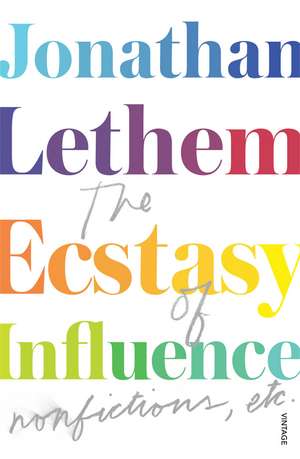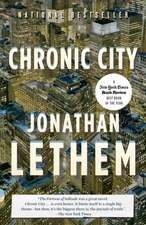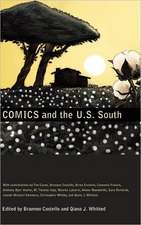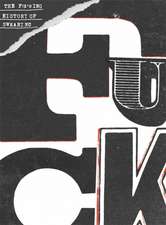The Ecstasy of Influence
Autor Jonathan Lethemen Limba Engleză Paperback – 7 mar 2013
| Toate formatele și edițiile | Preț | Express |
|---|---|---|
| Paperback (2) | 107.46 lei 3-5 săpt. | +13.51 lei 6-12 zile |
| Vintage Publishing – 7 mar 2013 | 107.46 lei 3-5 săpt. | +13.51 lei 6-12 zile |
| VINTAGE BOOKS – oct 2012 | 122.35 lei 6-8 săpt. |
Preț: 107.46 lei
Nou
Puncte Express: 161
Preț estimativ în valută:
20.56€ • 21.53$ • 17.06£
20.56€ • 21.53$ • 17.06£
Carte disponibilă
Livrare economică 20 martie-03 aprilie
Livrare express 05-11 martie pentru 23.50 lei
Preluare comenzi: 021 569.72.76
Specificații
ISBN-13: 9780099563433
ISBN-10: 0099563436
Pagini: 464
Dimensiuni: 130 x 195 x 35 mm
Greutate: 0.33 kg
Editura: Vintage Publishing
ISBN-10: 0099563436
Pagini: 464
Dimensiuni: 130 x 195 x 35 mm
Greutate: 0.33 kg
Editura: Vintage Publishing
Notă biografică
Jonathan Lethem is the New York Times-bestselling author of nine novels, including Dissident Gardens, The Fortress of Solitude and Motherless Brooklyn. A recipient of the MacArthur Fellowship and winner of the National Book Critics Circle Award, Lethem has also published his stories and essays in the New Yorker, Harper`s, Rolling Stone, Esquire and the New York Times, among others.
Descriere
This volume sheds light on an array of topics from sex in cinema to drugs, graffiti, Bob Dylan, cyberculture, 9/11, book touring and Marlon Brando. And, writing about Brooklyn, his father, and his sojourn through two decades of writing, one of the greats of contemporary American literature sheds an equally strong light on himself.
Extras
Postmodernism as Liberty Valance
Notes on a Ritual Killing
1. Spoiler alert. John Ford’s The Man Who Shot Liberty Valance is an allegorical Western that I am now going to totally pretzel into an allegory for something else entirely. Actually I’ll reverse it: The original allegorizes the taming of the western frontier, the coming of modernity in the form of the lawbooks and the locomotive, and memorializes what was lost (a loss the film sees as inevitable). My version allegorizes the holding at bay, for the special province of literary fiction, of contemporary experience in all its dismaying or exhilarating particulars, as well as a weird persistent denial of a terrific number of artistic strategies for illuminating that experience. The avoidance, that’s to say, of any forthright address of what’s called postmodernity, and what’s lost in avoiding it (a sacrifice I see as at best pointless, an empty rehearsal of anxieties, and at worst hugely detrimental for fiction).
2. The chewy center of TMWSLV is a gunfight. A man stands in the main street of a western town and (apparently) kills another man. The victim—for this is, technically, murder—represents chaos and anxiety and fear to all who know him, and has been regarded as unkillable, almost in the manner of a monster or zombie from another movie genre; his dispatch is regarded by the local population with astonished relief and gratitude, such that they will shower the killer with regard (he’s destined to become his party’s nominee for vice president of the United States). The secret the movie reveals: The killer was not the man in the street, but another.
3. The three persons in TMWSLV: James Stewart a.k.a. “Ransom Stoddard,” the upstanding, even priggish young lawyer from the east, defined by his naïve sincerity and dedication to the rule of law; John Wayne a.k.a. “Tom Doniphon,” cynical veteran of the frontier, who tends to an isolationist-libertarian approach toward civilization but is essentially lovable and will become heartbreaking by film’s end; and Lee Marvin a.k.a. “Liberty Valance,” a sadistic, amoral thug who delights in sowing chaos and exposing the fragility of social convention (by terrorizing family restaurants, newspaper offices, elections, etc.).
4. Stewart/Stoddard believes he’s “the man who killed Liberty Valance” (he stood, after all, in the center of town, visible to all, with a gun in his hand). More important, the witnesses believe he’s the one. In fact, it was Wayne/Doniphon who did the deed, while hidden in a shadowy alley, after having elaborately conspired to goad the helpless and pacifistic Stewart/Stoddard into his public role as a gun-toting defender of public peace against the savage anarchy of Marvin/Valance.
5. Liberty Valance, i.e., “Free Persuasion”—what an absurd, obvious, Pynchonian name! But then, the characters in Dickens and Henry James have odd names, too.
6. “Venturing back in time isn’t the only option for novelists loath to address the mass media that most Americans marinate in. There are also those populations cut off from the mainstream for cultural reasons, such as recent immigrants and their families. And then there are those at the geographical margins . . . It’s remarkable how many recent American literary novels and short stories are set on ranches . . . The American novelist is buffeted by two increasingly contradictory imperatives. The first comes as the directive to depict ‘The Way We Live Now’ . . . Cliché it may be, but the notion that no one is better suited to explain the dilemmas of contemporary life than the novelist persists . . . [The] other designated special province of the literary novelist: museum-quality depth. The further literature is driven to the outskirts of the culture, the more it is cherished as a sanctuary from everything coarse, shallow and meretricious in that culture. If these two missions seem incompatible, that’s because they are. To encompass both . . . you must persuade your readers that you have given them what they want by presenting them with what they were trying to get away from when they came to you in the first place.”
—Laura Miller, The Guardian
7. Let’s wade into the unpleasantness around the term “postmodernism”: Nobody agrees on its definition, but in literary conversations the word is often used as finger-pointing to a really vast number of things that might be seen as threatening to canonical culture: author-killing theories generated by French critics, collapsings of high and low cultural preserves into a value-neutral fog, excessive reference to various other media and/or mediums, especially electronic ones (ironically, even a Luddishly denunciatory take on certain media and/or mediums may be suspect merely for displaying an excess of familiarity with same), an enthusiasm for “metafiction” (a word that ought to be reserved for a specific thing that starts with Cervantes, but isn’t), for antinarrative, for pop-culture references or generic forms, for overt (as opposed to politely passive) “intertextuality,” for unreliable narration, for surrealism or magic realism or hysterical realism or some other brand of “opposed- to- realism” affiliation, for “irony” (another term that’s been abused out of its effective contour and function, and its abusers have fewer excuses than do those of postmodernism), etc. etc. etc. Now, any writer espousing, let alone employing, all of the above things would be a gorgon-headed monster, surely deserving rapid assassination for the safety of the literary community in general. (Or maybe not, maybe they’d be splendid.) But—and I present this as axiomatic—such a person, and such writing, is impossible to consider seriously because all of the modes denounced under the banner of “postmodernist” are incompatible: You can’t, just for instance, exalt disreputable genres like the crime story and also want to do away with narrative.
8. The reverse person, a literary person inclined toward or at least compelled by none of the above-named modes or gestures—and I present this not as axiomatic but as an obnoxious opinion—would be dull beyond belief. They basically would have declined the entire twentieth century (and interesting parts of several others). You’ve read our entire menu, sir? And nothing was of interest? Really, nothing?
9. “ . . . as a phenomenon, postmodernism is either specifically aesthetic or more generally cultural; it is either revolutionary or reactionary; it is either the end of ideology or the inescapable conclusion of ideology . . . It is expressed in architecture, art, literature, the media, science, religion and fashion, and at the same time it is equivalent to none of these. It is both a continuation and intensification of what has gone before and a radical break with all traces of the past. It is, above all, simultaneously critical and complicit.”
—Kathleen Fitzpatrick, The Anxiety of Obsolescence
“Critical debates about postmodernism constitute postmodernism itself.”
—Stephen Connor, Postmodernist Culture
10. I suggested that abusers of the word “postmodernism” had excuses. I offer the above quotes as exculpatory evidence. The serious use of the term manifestly propagates bewilderment. But the quotes are also a reminder that the term has serious uses. It means more than “art I don’t like.”
11. What postmodernism really needs is a new name—or three of them.
12. The first “postmodernism” that requires a new name is our sense— I’m taking it for granted that you share it—that the world, as presently defined by the advent of global techno-capitalism, the McLuhanesque effects of electronic media, and the long historical postludes of the transformative theories, movements, and traumas of the twentieth century, isn’t a coherent or congenial home for human psyches. Chuck Klosterman details this suspicion in his essay on the Unabomber, called “FAIL” (though it might as well be called “Sympathy for Theodore Kaczynski”). His conclusion, basically, is that in the teeth of contemporary reality we’d all be a little bit crazy not to sometimes wish to kill that sort of postmodernism. I speak here as one who’s spent loads of his own good faith hurling tiny word-bombs at the rolling edifice of the triumphalist Now. This postmodernism we’ll call Kaczynski’s Bad Dream.
13. The second substitute term I’ll offer is for the avowed, self-declared postmodernist school of U.S. fiction writers: Robert Coover, John Barth, Donald Barthelme, Stanley Elkin, William Gass, John Hawkes, a few others, many of them one another’s friends, and many of them influential teachers. A few non-teachers—Pynchon, of course (unless he was teaching high-school social studies or geometry somewhere). This clan, when Barth and Pynchon were scooping up major prizes, rode high enough that they seemed worth knocking down. This is the epoch John Gardner tilted against in On Moral Fiction. True, this tribe once had the effrontery to imagine itself the center of interest in U.S. fiction, but if you still hold that grudge your memory for effrontery is too long. To go on potshotting at these gentlemen is not so much shooting fish in a barrel as it is shooting novelists who rode a barrel over Niagara Falls twenty or thirty years ago. Or the equivalent of the Republican Party running its presidential candidates against the memory of George McGovern. (Of course, both are done, routinely.) We’ll call these guys Those Guys.
14. Last, the “postmodernism” consisting simply of what aesthetic means and opportunities modernism and an ascendant popular culture left in their wake (or not their wake, since both, or at least popular culture, are still around). By “means and opportunities” I am alluding to the vastly expanded and recombinant toolbox of strategies, tones, traditions, genres, and forms that a legacy of modernist-style experimentation, as well as a general disintegration of boundaries (between traditions, tones, etc.), has made available to a writer, or to any kind of artist. Luc Menand made this very simple in an essay on how Donald Barthelme’s stories go on stubbornly regenerating their uses and interest for new generations of readers; he suggested that postmodernism, as an artistic movement, represents the democratization of modernism’s impulses and methods. We’ll call this third principle, for the sake of my allegory, Liberty Valance.
15. I’d like to suggest that the killing of Liberty Valance in order to preserve safety and order in the literary town is a recurrent ritual, a ritual convulsion of literary-critical convention. The chastening of Those Guys, and the replacement of their irresponsible use of Free Power with a more modest and morally serious minimalist aesthetic sometime in the late ’70s, was a kind of Gunfight at the O.K. Corral, a point of inception for the ritual. Who first played the role of Stewart/ Stoddard, the true-of-heart citizen shoved into the street to take on the menacing intruder? Was it Raymond Carver? I think Raymond Carver might have been the original Man Who Shot Liberty Valance. Who’s played the role recently? A few: Alice Munro, William Trevor, Cormac McCarthy, Marilynne Robinson, Jonathan Franzen.
16. The worth, or the intentions, of the writer propped up on Main Street as the killer of postmodernism is not the point. The person (or book) in the street is a surrogate. The Wayne/Doniphon figure is the critic in the shadows, maneuvering the writer in question in a contest of the critic’s devising (excepting, I suppose, the John Gardner or Tom Wolfe scenario of self- appointment, where both roles are played by the same actor). According to the critic’s presentation the writer has, at last, killed Liberty Valance on behalf of the terrified populace. Yet the terrified populace is probably a straw man, too, a projection of the critic’s own fear of disreputability or disorder.
17. The persistence of the ritual disproves the ostensible result: Liberty Valance is shot, but never dies. (“Leopards break into the temple and drink the sacrificial chalices dry; this occurs repeatedly, again and again; finally it can be reckoned upon beforehand and becomes part of the ceremony.”—Kafka.) Books don’t kill other books, nor do literary stances or methods kill, or disqualify, differing sorts, and those— stances and methods—don’t actually originate from moral positions per se. A given book elaborates its own terms, then succeeds or fails according to them, including on the level of morals. None of this ensures the accomplishment of any writer working in any methodology (whether consciously or in merry obliviousness to the range of options available). A book as full of misrule, as seemingly heedless to ethical consequence as Marvin/Valance in John Ford’s film, might be as sacred as any other.
18. The reason postmodernism doesn’t die isn’t that the man in the shadows has a peashooter instead of a weapon. Critics do kill things: books frequently, careers from time to time (just ask Those Guys). The reason postmodernism doesn’t die is that postmodernism isn’t the figure in the black hat standing out in the street squaring off against the earnest and law-abiding “realist” novel against which it is being opposed. Postmodernism is the street. Postmodernism is the town. It’s where we live, the result of the effects of Liberty Valance’s stubborn versatility and appeal, and the fact of Kaczynski’s Bad Dream.
19. Yet Liberty Valance and Kaczynski’s Bad Dream aren’t the same “postmodernism.” The freedom and persuasiveness of the full array of contemporary stances and practices available to the literary artist aren’t something to renounce even if the Full Now makes us anxious to the verge of nervous breakdown. At its best, one is a tool for surviving the other—the most advanced radiation suit yet devised for wandering into the toxic future.
20. Changing metaphors entirely at the last minute: Both Kabuki and Noh theater began as fluid popular forms, licensed to depict their own contemporary reality, before sealing themselves within sacralized pools of approved forms, metaphors, and references. And in the history of twentieth-century popular music there’s a name for the school of jazz that glanced at the innovations of bebop and all the implications and possibilities of what lay beyond, but declined to respond. The name for that school is Dixieland.
From the Hardcover edition.
Cuprins
i: My Plan to Begin With
My Plan to Begin With, Part One
The Used Bookshop Stories
The Books They Read
Going Under in Wendover
Zelig of Notoriety
Clerk
ii: Dick, Calvino, Ballard: SF and Postmodernism
My Plan to Begin With, Part Two
Holidays
Crazy Friend (Philip K. Dick)
What I Learned at the Science-Fiction Convention
The Best of Calvino: Against Completism
Postmodernism as Liberty Valance
The Claim of Time (J. G. Ballard)
Give Up
iii: Plagiarisms
The Ecstasy of Influence
The Afterlife of “Ecstasy”/Somatics of Influence
Always Crashing in the Same Car
Against “Pop” Culture
Furniture
iv: Film and Comics
Supermen!: An Introduction
Top-Five Depressed Superheroes
The Epiphany
Izations
Everything Is Broken (Art of Darkness)
Godfather IV
Great Death Scene (McCabe & Mrs. Miller)
Kovacs’s Gift
Marlon Brando Breaks
Missed Opportunities
Donald Sutherland’s Buttocks
The Drew Barrymore Stories
v: Wall Art
The Collector (Fred Tomaselli)
An Almost Perfect Day (Letter to Bonn)
The Billboard Men (Larry Sultan and Mike Mandel)
Todd James
Writing and the Neighbor Arts
Live Nude Models
On a Photograph of My Father
Hazel
vi: 9/11 and Book Tour
Nine Failures of the Imagination
Further Reports in a Dead Language
To My Italian Friends
My Egyptian Cousin
Cell Phones
Proximity People
Repeating Myself
Bowels of Compassion
Stops
Advertisements for Norman Mailer
White Elephant and Termite Postures in the Life of the Twenty-first-Century Novelist
vii: Dylan, Brown, and Others
The Genius of James Brown
People Who Died
The Fly in the Ointment
Dancing About Architecture
Dylan Interview
Open Letter to Stacy (The Go-Betweens)
Otis Redding’s Lonely Hearts Club Band
Rick James
an orchestra of light that was electric
viii: Working the Room
Bolaño’s 2666
Homely Doom Vibe (Paula Fox)
Ambivalent Usurpations (Thomas Berger)
Rushmore Versus Abundance
Outcastle (Shirley Jackson)
Thursday (G. K. Chesterton)
My Disappointment Critic/On Bad Faith
The American Vicarious (Nathanael West)
ix: The Mad Brooklynite
Ruckus Flatbush
Crunch Rolls
Children with Hangovers
L. J. Davis
Agee’s Brooklyn
Breakfast at Brelreck’s
The Mad Brooklynite
x: What Remains of My Plan
Micropsia
Zeppelin Parable
What Remains of My Plan
Memorial
Things to Remember
My Plan to Begin With, Part One
The Used Bookshop Stories
The Books They Read
Going Under in Wendover
Zelig of Notoriety
Clerk
ii: Dick, Calvino, Ballard: SF and Postmodernism
My Plan to Begin With, Part Two
Holidays
Crazy Friend (Philip K. Dick)
What I Learned at the Science-Fiction Convention
The Best of Calvino: Against Completism
Postmodernism as Liberty Valance
The Claim of Time (J. G. Ballard)
Give Up
iii: Plagiarisms
The Ecstasy of Influence
The Afterlife of “Ecstasy”/Somatics of Influence
Always Crashing in the Same Car
Against “Pop” Culture
Furniture
iv: Film and Comics
Supermen!: An Introduction
Top-Five Depressed Superheroes
The Epiphany
Izations
Everything Is Broken (Art of Darkness)
Godfather IV
Great Death Scene (McCabe & Mrs. Miller)
Kovacs’s Gift
Marlon Brando Breaks
Missed Opportunities
Donald Sutherland’s Buttocks
The Drew Barrymore Stories
v: Wall Art
The Collector (Fred Tomaselli)
An Almost Perfect Day (Letter to Bonn)
The Billboard Men (Larry Sultan and Mike Mandel)
Todd James
Writing and the Neighbor Arts
Live Nude Models
On a Photograph of My Father
Hazel
vi: 9/11 and Book Tour
Nine Failures of the Imagination
Further Reports in a Dead Language
To My Italian Friends
My Egyptian Cousin
Cell Phones
Proximity People
Repeating Myself
Bowels of Compassion
Stops
Advertisements for Norman Mailer
White Elephant and Termite Postures in the Life of the Twenty-first-Century Novelist
vii: Dylan, Brown, and Others
The Genius of James Brown
People Who Died
The Fly in the Ointment
Dancing About Architecture
Dylan Interview
Open Letter to Stacy (The Go-Betweens)
Otis Redding’s Lonely Hearts Club Band
Rick James
an orchestra of light that was electric
viii: Working the Room
Bolaño’s 2666
Homely Doom Vibe (Paula Fox)
Ambivalent Usurpations (Thomas Berger)
Rushmore Versus Abundance
Outcastle (Shirley Jackson)
Thursday (G. K. Chesterton)
My Disappointment Critic/On Bad Faith
The American Vicarious (Nathanael West)
ix: The Mad Brooklynite
Ruckus Flatbush
Crunch Rolls
Children with Hangovers
L. J. Davis
Agee’s Brooklyn
Breakfast at Brelreck’s
The Mad Brooklynite
x: What Remains of My Plan
Micropsia
Zeppelin Parable
What Remains of My Plan
Memorial
Things to Remember
Recenzii
“I love this book. . . . Less of a collection than a collage, a cut-and-paste self-portrait in which we see Lethem as he sees himself. . . . A book about a big idea.” —David L. Ulin, Los Angeles Times
“Begins with this idea of writer-as-magpie and takes it on a communitarian-artistic romp. . . . It’s a grand performance. . . . And delivered with a wink.” —San Francisco Chronicle
“Like almost everything Lethem has written, The Ecstasy of Influence is a reflection of, and a pixilated homage to, those whose work he fetishizes. If this book has a thesis, it’s this: For an artist, influence is everything.” —The New York Times
“[An] exuberant whiz-bang of an essay collection.” —The Daily Beast
“Hefty and remarkable. . . . Dominating all is Lethem’s prime concern always: the novel. . . . More exciting than any of his interesting-to-terrific fiction.” —Robert Christgau, The New York Times Book Review
“[Lethem is] as sharp a critic as he is a novelist. This collection shows you why.” —Austin American-Statesman
“Lethem takes a boldly different tack on the matter of mentors, gurus, fathers, shapers and sources. . . . He not only acknowledges his literary and psychological progenitors; he insists upon them, celebrates them, and invites the reader to join in an exhilarating if sometimes baffling deconstruction of the very idea of influence.” —The Dallas Morning News
“Lethem’s inspired miscellany is ardent and charming. . . . His essays are zippy and freewheeling.”—Chicago Tribune
“Sharp and funny.” —The Plain Dealer
“Frank and boisterous. . . . The Ecstasy of Influence is, more than anything, a record of Mr. Lethem’s life as a public novelist, a role for which he is obviously well suited. . . . Mr. Lethem has such a gift, and The Ecstasy of Influence is evidence of it.” —The New York Observer
“This impassioned, voluble book is illuminating about much more than its author.”—The Independent (London)
“The Ecstasy of Influence is in part an attempt to discuss the things artists and writers rarely talk about—how much of their work is borrowed from other artists and how much they care about their critical reputations, among other things.” —Salon
“Smart and rollicking. . . . Brilliantly dissect[s] the various sulks, funks, and paranoias of being a writer who moans about doing writerly things—not least among them writing itself.” —The Millions
“A wide and wonderful series of subjects that are threaded together, mostly, as a kind of autobiography of a would-be writer becoming a struggling writer and then a successful writer while all the while remaining a voracious reader.” —National Post (Canada)
“The author invites us into the ecstasy of intertextuality, to the intertwining of thousands of words with ourselves.”—PopMatters
"The arguments implicit in his novels are not merely explicit here, but deliriously so, ecstatically so, as if the author is shaking you by the shoulders to show you what he loves, why he loves it and why you should love it, too.” —Kirkus Reviews (starred review)
“Begins with this idea of writer-as-magpie and takes it on a communitarian-artistic romp. . . . It’s a grand performance. . . . And delivered with a wink.” —San Francisco Chronicle
“Like almost everything Lethem has written, The Ecstasy of Influence is a reflection of, and a pixilated homage to, those whose work he fetishizes. If this book has a thesis, it’s this: For an artist, influence is everything.” —The New York Times
“[An] exuberant whiz-bang of an essay collection.” —The Daily Beast
“Hefty and remarkable. . . . Dominating all is Lethem’s prime concern always: the novel. . . . More exciting than any of his interesting-to-terrific fiction.” —Robert Christgau, The New York Times Book Review
“[Lethem is] as sharp a critic as he is a novelist. This collection shows you why.” —Austin American-Statesman
“Lethem takes a boldly different tack on the matter of mentors, gurus, fathers, shapers and sources. . . . He not only acknowledges his literary and psychological progenitors; he insists upon them, celebrates them, and invites the reader to join in an exhilarating if sometimes baffling deconstruction of the very idea of influence.” —The Dallas Morning News
“Lethem’s inspired miscellany is ardent and charming. . . . His essays are zippy and freewheeling.”—Chicago Tribune
“Sharp and funny.” —The Plain Dealer
“Frank and boisterous. . . . The Ecstasy of Influence is, more than anything, a record of Mr. Lethem’s life as a public novelist, a role for which he is obviously well suited. . . . Mr. Lethem has such a gift, and The Ecstasy of Influence is evidence of it.” —The New York Observer
“This impassioned, voluble book is illuminating about much more than its author.”—The Independent (London)
“The Ecstasy of Influence is in part an attempt to discuss the things artists and writers rarely talk about—how much of their work is borrowed from other artists and how much they care about their critical reputations, among other things.” —Salon
“Smart and rollicking. . . . Brilliantly dissect[s] the various sulks, funks, and paranoias of being a writer who moans about doing writerly things—not least among them writing itself.” —The Millions
“A wide and wonderful series of subjects that are threaded together, mostly, as a kind of autobiography of a would-be writer becoming a struggling writer and then a successful writer while all the while remaining a voracious reader.” —National Post (Canada)
“The author invites us into the ecstasy of intertextuality, to the intertwining of thousands of words with ourselves.”—PopMatters
"The arguments implicit in his novels are not merely explicit here, but deliriously so, ecstatically so, as if the author is shaking you by the shoulders to show you what he loves, why he loves it and why you should love it, too.” —Kirkus Reviews (starred review)















